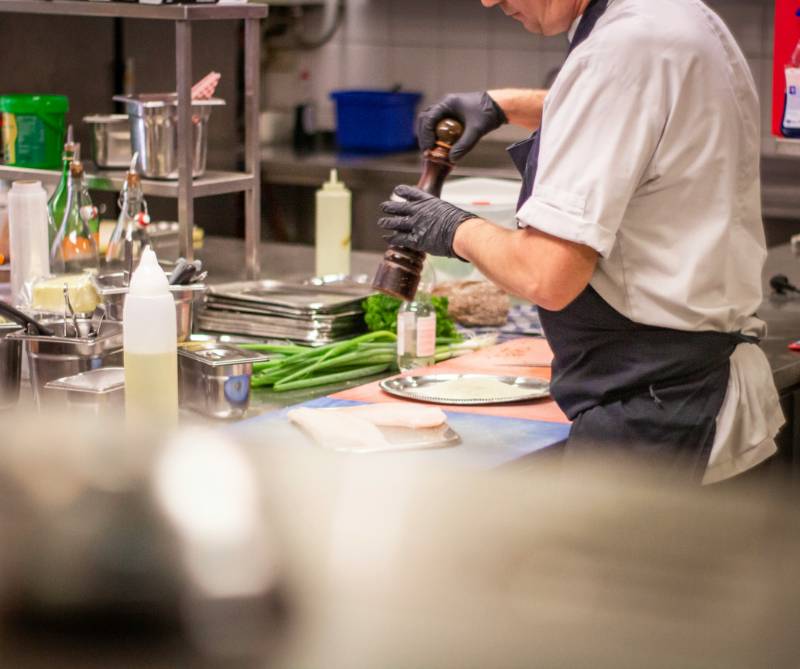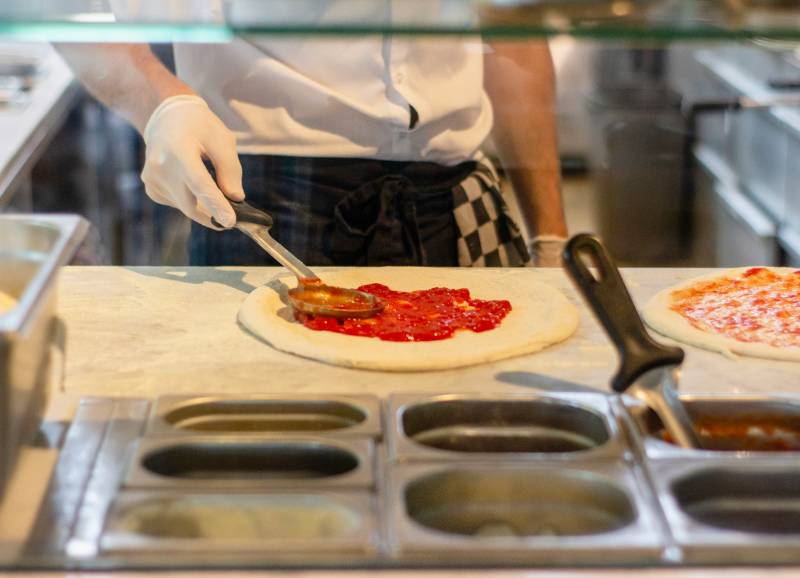Kitchen Colour Codes: The Ultimate Guide
 In the bustling environment of a commercial or public sector kitchen, organisation and hygiene are paramount. Among the many practices that ensure a safe and efficient workspace, kitchen colour coding stands out as one of the simplest yet most effective methods of ensuring food safety and reducing the risk of cross-contamination. But what exactly is food colour coding and what are the items that need to be colour coded in your kitchen? Read on to find out all about the kitchen colour code system for professional kitchens.
In the bustling environment of a commercial or public sector kitchen, organisation and hygiene are paramount. Among the many practices that ensure a safe and efficient workspace, kitchen colour coding stands out as one of the simplest yet most effective methods of ensuring food safety and reducing the risk of cross-contamination. But what exactly is food colour coding and what are the items that need to be colour coded in your kitchen? Read on to find out all about the kitchen colour code system for professional kitchens.
- What is meant by the colour coding of kitchen equipment?
- Why are kitchen colour codes important?
- The kitchen items you need to colour code
- The kitchen colour codes
- Other ways to reduce the risk of cross-contamination in a kitchen
What is meant by the colour coding of kitchen equipment?
Kitchen colour coding involves assigning specific colours to various catering essentials, including utensils, tools, and catering equipment. The purpose is to separate items based on their designated tasks or areas of use. This system is essential for any professional kitchen as it aids in preventing cross-contamination, ensuring that equipment intended for one type of food does not come into contact with another, thus maintaining food safety standards.
Why are kitchen colour codes important?
Colour coding is a key cornerstone of food safety and the importance of it cannot be overstated. For starters, kitchen colour coding helps prevent cross-contamination. This in turn reduces the risk of foodborne illnesses, as well as ensures your kitchen and employees are adhering to the standards set by the Food Standards Agency. Following a kitchen colour coding system can even have some cost savings benefits by helping your staff reduce the amount of food spoilage and waste due to contamination.
Colour coding is also vital when it comes to allergens. Diners with severe allergies should not be served food which has been prepared using equipment that has come into contact with their allergen. By sticking to a clear colour coding system, it’s much easier to ensure that they are not exposed to these allergens.
As well as coming with ample food safety and hygiene benefits, colour-coding can also help with keeping kitchens organised and efficient. By quickly identifying which tools or ingredients belong to which category, your chefs and kitchen staff can work more smoothly and reduce confusion in a busy and bustling kitchen.
Is there a universal colour-coding system for food?
Yes, there is a standardised universal colour coding system for food. However, it is worth noting that adhering to kitchen colour codes is not a legal requirement for professional catering businesses. Despite this, it is still recommended that professional kitchens adhere to these standardised food colour codes. Not only is it good practice and important for reducing cross-contamination risks, but it shows Environmental Health Officers (EHO) that you are taking food hygiene measures seriously, which is an essential thing to demonstrate in your EHO inspections.
The kitchen items you need to colour code

There are a number of kitchen items which can be colour coded for food safety and hygiene, including the following:
- Chopping boards: Perhaps the most common kitchen essential associated with the food colour coding system, there are seven main chopping board colours, all of which we’ll cover in the kitchen colour codes section.
- Knives: Your kitchen knife set should also be colour-coded to reduce the risk of cross-contamination. We have a premium quality stainless steel colour-coded 6 piece knife set and wallet which is sure to be perfect for your kitchen.
- Utensils: As well as knives, other kitchen utensils like tongs and scissors, can be colour coded.
- Thermometers: Kitchen thermometers are used for a variety of different foods, from meat to baked goods, so having different coloured thermometers for each is important when it comes to protecting those with allergies.
- Aprons: Protective clothing like aprons can also help when it comes to reducing cross-contamination and promoting food hygiene.
Another way to ensure your kitchen is adhering to the system as much as possible is to use colour-coding labels on food containers. Doing so can quickly indicate the presence of common allergens to staff, such as peanuts, tree nuts, dairy, gluten, and shellfish.
The kitchen colour codes

As we already know, colour coding is not a legal requirement, and even if establishments do choose to apply a system of kitchen colour codes, it does not necessarily have to follow the commonly used standardised system. However, using this already-established food colour coding system is likely best for your business, especially when it comes to hiring new kitchen staff who are already acquainted with these colour codes. Using the universal food colour codes also means you can have a handy colour-coded wall chart in your kitchen to ensure your staff are always aware of which colours to use and when.
So, what exactly are the different coloured chopping boards and other food preparation equipment used for? Below are the seven common kitchen colour codes and their associated food categories:
- Red – raw meat: Red cutting boards, knives, and utensils are used exclusively for handling raw meat.
- Blue – seafood: Blue-coloured equipment is designated for handling seafood. This is especially important for preventing the risk of allergic reactions, as crustaceans are one of the 14 most common food allergies.
- Green – fruit and vegetables: Green cutting boards and utensils are reserved for preparing fruits and vegetables, helping to maintain their freshness and prevent contamination from meat products.
- Yellow – cooked meats: Yellow-coded items are used for handling cooked meats, ensuring that they remain free from harmful bacteria present in raw meat.
- White dairy and bakery products: White equipment is typically used for dairy products and bakery items, such as pastries.
- Brown - root vegetables: Brown-coloured tools and cutting boards are often designated for preparing root vegetables, such as potatoes and carrots.
- Purple – allergen-free: Purple chopping boards and utensils are specifically designated for allergen-free foods, such as gluten-free or nut-free items, to prevent cross-contact with allergens.
What colour cleaning equipment should be used in kitchens?
It isn’t just the food preparation equipment that should be colour coded in your kitchen, but the cleaning supplies too, in order to reduce the risk of infection spreading. The colour of the materials used to clean kitchens and food preparation areas is green. The janitorial items you should colour code include aprons, gloves, mops and buckets, dustpans, brushes, and brooms.
Other ways to reduce the risk of cross-contamination in a kitchen

While kitchen colour coding is an essential component of maintaining hygiene standards in your establishment, it is not the only measure that can be taken to reduce the risk of cross-contamination. Below are some additional strategies your kitchen workers can take to enhance food safety.
Regular cleaning and sanitisation
Regular and thorough cleaning of all surfaces, equipment, and utensils is the cornerstone of preventing both cross-contamination and the build-up of bacteria. Develop a thorough cleaning schedule that includes daily, weekly, and monthly tasks, ensuring that every area of the kitchen is addressed. Make sure to pay particularly close attention to high-touch areas such as handles, knobs, and countertops. We have a wide range of strong cleaning products here at CLH Healthcare, including kitchen cleaners, degreasers, and concentrated cleaning products, perfect for professional kitchens, including options available to buy in bulk.
Staff training and education
Proper staff training is vital for maintaining a hygienic kitchen environment. Kitchen management should take time to educate their team about the risks of cross-contamination and the importance of following hygiene protocols. Provide comprehensive training on proper handwashing techniques, safe food handling practices, and the use of cleaning chemicals. Regular refresher courses will reinforce these principles and keep your staff informed about the latest food safety guidelines. You should also ensure you make it as easy as possible for staff to put this training into practice, such as by having ample handwashing and sanitiser stations around the kitchen.
Set up separate storage and preparation areas
Designating separate areas for storing raw and cooked foods is an effective way to prevent the risk of cross-contamination. Keep raw meats, seafood, and poultry stored at the bottom of refrigerators or in separate compartments to avoid drips onto other foods. If you have the space in your kitchen you may even want to designate separate fridges for raw meats, fish, and poultry. You should also implement clear procedures for handling and transporting food to minimise the risk of contamination during preparation.
Conduct regular inspections and audits
Regular inspections and audits are essential for not just identifying potential hazards and areas for improvement, but for ensuring compliance with food safety regulations and preparing for an EHO inspection. Schedule routine check-ups of your kitchen facilities, equipment, and storage areas to assess cleanliness and hygiene practices. You can also conduct audits to evaluate whether staff adhere to all the food safety protocols and address any areas of concern promptly.
A food colour coding system is a simple yet effective tool for maintaining hygiene standards and preventing cross-contamination in a professional kitchen. By implementing a consistent kitchen colour code scheme for chopping boards, utensils, and other food preparation equipment, your establishment can promote food safety, enhance efficiency, and safeguard the health of your diners.
We have a wide range of colour-coded food essentials in our catering collection, as well as other kitchen and dining essentials such as glassware, crockery, poly plastics, kitchen disposables, and more. Shop our full range today to enhance your catering set-up. And don’t forget to check out more of our guides in the learning centre for tips on creating a care home food menu, promoting independence in a care home, and more.





